Southwest Michigan fruit regional report – April 26, 2016
Fruit trees are blooming and growers are applying protectant sprays before the rains later this week.

Weather
Last week was warm and dry. High temperatures started in the 80s with lows above 50. The mid- and late week was cooler with highs near 60. There was little rain last week and soils were becoming dry. The weekend was warm again and highs reached near 80 on Monday, April 25. Strong thunderstorms moved across western Michigan Monday night. These storms dropped from 0.2 to 1.5 inches of rain and hail was reported in some areas.
This week started warm and wet on Monday. Plants have developed rapidly and stone fruit are blooming. This week looks to be wetter, so blossom brown rot may be a problem. High temperatures for the week are forecast to be in the 50s for mid-week and rising into the 60s for the weekend. Low temperatures will be around 40. No freezes are in the forecast, but there is still a chance of a damaging freeze into early May. We are currently about a week ahead of normal for heat accumulation in growing degree-days (GDD). Cooler weather this week will slow down plant development.
|
Southwest Michigan GDD summary from Jan. 1 to April 24, 2016 |
|||
|---|---|---|---|
|
Station |
GDD 42 F |
GDD 45 F |
GDD 50 F |
|
Benton Harbor (SWMRC) |
400 |
314 |
199 |
|
Lawton (Lawton) |
383 |
298 |
186 |
|
Fennville (TNRC) |
311 |
237 |
142 |
|
Average for the region |
360 |
278 |
171 |
|
Accumulation last week |
99 |
87 |
62 |
Bees in the fruit planting
Commercial bee hives are in many fruit orchards and plantings. Bees were very busy Monday, April 25, working on blooming fruit trees. Growers should use care in applying pesticides during bloom. Avoid using insecticides which can kill bees. Do not spray during the middle of the day when bees are foraging. Try applying pesticides during early morning or early evening when bees are less likely to be foraging and exposed to the spray operation. Contact your beekeeper and have bee hives removed before applying post-bloom and petal fall sprays, which include insecticides.
Tree fruit
Stone fruit are blooming and should be protected from blossom brown rot. Insect activity has really increased in the last two weeks. Green fruitworm moths have been flying for two weeks. Larvae from this insect is among the first to target fruit after petal fall. Oriental fruit moth flight has begun. Eastern tent caterpillar webs can be seen on wild fruit trees and Michigan State University Extension advises growers inspect their plantings for this pest.
Apricots are in the shuck. There is a crop of apricots, but an accurate assessment will have to wait until after the fruit comes out of the shuck. There may still be a significant fruit drop.
Peaches are at full bloom to petal fall. Pollination conditions were good last week. Growers will assess the effectiveness of pollination in several weeks when fruit emerges from the shuck. Growers should maintain protection against blossom brown rot. Biofix first flight of oriental fruit moth was set on Monday, April 25, based on trap catches at the Trevor Nichols Research Center trap line. Biofix is used for timing sprays against the larvae, which can cause flagging damage on branch tips of young peach trees. Pheromones for mating disruption should be out. The rain this week will favor bacterial spot infection of young leaves.
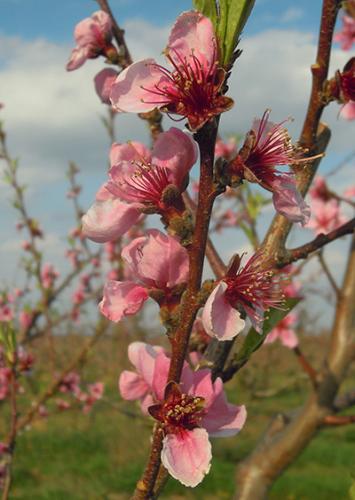
Peach flowers showing the large pink petals of the “showy” type of peach blossom.
Sweet cherries are past full bloom. Sweet cherry petals linger longer than most other fruit trees. Pollination has probably been completed. Sweet cherries are very susceptible to brown rot, so growers should apply sprays to reduce blossom brown rot.
Tart cherry flowers began to open last Friday, April 22. Most orchards are now at full bloom. There was little if any damage to tart cherries. Crop potential for most sites is good to excellent.
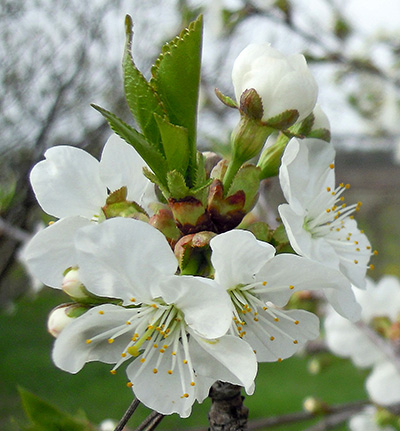
All the buds have opened and almost all the flowers are open on this Montmorency tart cherry spur.
Japanese plums are in the shuck.
European plums are at full bloom. Plums need to be protected against black knot from first bloom until second cover.
Apple flower clusters are opening. Growers have been applying oil sprays for control of San Jose scale and mites. Bloom has begun in the early varieties, early crab apple pollinizers and escaped trees in the woods. There is a wide variation in apple bloom across the region. Early varieties such as Zestar are at full bloom in Berrien County. In Van Buren County, most varieties are at full pink or just starting to open.
Open bloom and warm weather are good conditions for fire blight. Warm temperature early this week were identified by the Maryblyt model as approaching a high risk level for fire blight for the southern part of the district. Rain and hail from Monday night’s storms has growers with open bloom putting on antibiotics to prevent or reduce fire blight infection. Other areas were not as far along or had cooler temperatures, which reduced the risk. Hail in orchards with a history of fire blight is the major driver of sprays to prevent trauma blight.
Apple scab ascospores have been trapped over the last month in relatively low numbers, but spore numbers jumped up with last week’s rains. Several scab infection periods have been recorded in the region and leaf scab symptoms could be appearing this week. Spotted tentiform leafminer have been flying for about two weeks. Redbanded leafroller trap catch is high.
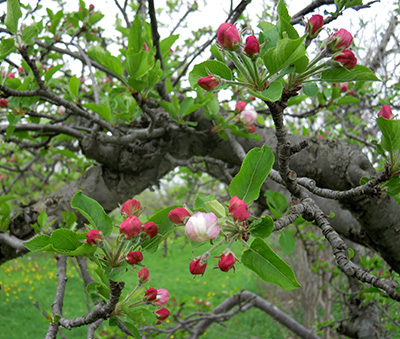
Red Delicious are at full pink and the flowers will begin to open with a little warm weather.
Pears are at full bloom. Pear psylla adults are flying. Pears also need to be protected against pear scab and fire blight.
Small fruit
Juice grape buds are at bud burst. The bud has opened, but no leaves have folded back from the bud. Hybrid grapes are at early to late swell. Vinifera grapes are starting to swell. As the buds open and shoot growth begins, shoot tissue becomes vulnerable to infection from powdery mildew, phomopsis and black rot. Fungicides to control these diseases are usually applied as flower clusters become visible. Grape flea beetles and climbing cutworms will be feeding in vineyards where they are present. Where problems with these pests have appeared in the past, scout weekly from now until 3 inches of growth.
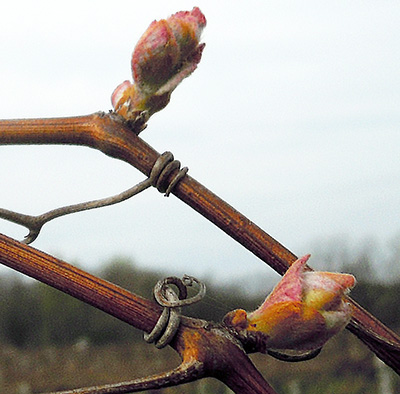
Concord shoot buds opening south of Lawton, Michigan.
Blueberry flower buds are at tight cluster to pink bud depending on the variety and site. The bud set looks very heavy in some areas. Blueberry bloom has started in southern Berrien County. Green leaf tissue is exposed and leaves are starting to unfold. Plant development will slow this week with the cooler weather.
Growers should apply treatments before this week’s rain to reduce mummy berry shoot blight. As bloom opens, the control strategy changes to preventing flower infection and preventing the fruit rot phase of this disease. Bees and other pollinators carry mummy berry spores from shoot strikes to open bloom, so good pollinating conditions are good mummy berry infection conditions if there are shoot strikes in the area. The flowers a susceptible to infection as they open and susceptibility declines as the flowers age. Sprays are timed for early bloom and mid-bloom.
At petal fall, anthracnose is a concern and the preferred fungicide changes to include action against anthracnose, mummy berry and phomopsis. Growers should avoid spraying in the middle of the day when bees are foraging the bloom.
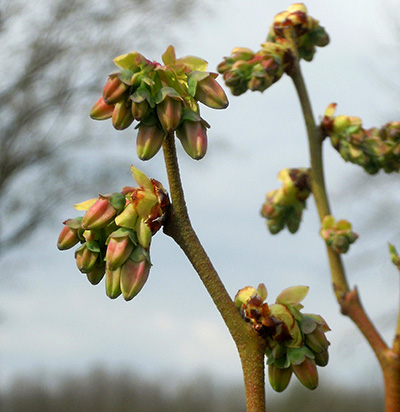
Draper blueberry flower buds at late pink bud. These flowers will open soon.
Strawberry leaves are still emerging from the crown as well as the flower trusses. Once the flower buds emerge they can be killed by temperatures in the 20s. Leaf diseases are the primary concern in strawberries at this time. Common strawberry leaf spot is the chief concern. If the weather is wetter than predicted, angular leaf spot could be a problem.
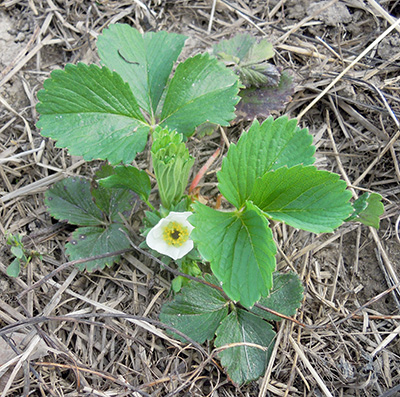
This strawberry flower was exposed and the pistils at the center were killed by freezing weather three weeks ago. There will be no strawberry from this flower, but there are many other flowers on this plant and in this field.
Bramble growth is well underway. Leaves are unfolding in raspberries and the flower clusters can be seen. The main concern is orange rust in blackberries and black raspberries. Effective controls can be found in the 2016 Michigan Fruit Management Guide (E0154).
Cranberries are just starting to green up and bud swell can be seen in the warmer fields.
Miscellaneous fruit crops
Paw Paws and saskatoons are blooming.
Upcoming Meetings
Our next Monday fruit IPM meeting in southwest Michigan is May 2 at Fruit Acres Farms, 2559 Friday Road on the northeast corner of Friday and Carmody Roads, south of Coloma, at 5 p.m. Two Michigan pesticide applicator recertification credits will be given for these meetings.
Related articles
- Minimizing pesticide exposure to bees in fruit crops
- Considerations for pre-bloom and bloom sprays for American brown rot
- Management of bacterial spot on peaches and nectarines
- How to use Enviro-weather’s apple scab tool
- SDHI fungicides for apple scab management
- Update on resistance to strobilurin fungicides in the apple scab fungus in Michigan
- How to use the Enviroweather Fire Blight Model
- A primer for Streptomycin, Kasumin and Oxytetracycline use for fire blight management
- Apogee for fire blight (shoot blight) managemen
- Protect new grape shoots from early-season fungal diseases
- Managing mummy berry shoot strike infections
- Mummy berry management in blueberries during bloom
- Invest in pollination for success with highbush blueberries
- Monitor for orange rust in brambles



 Print
Print Email
Email
